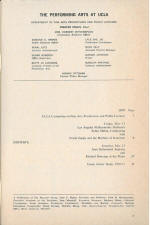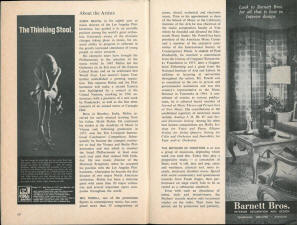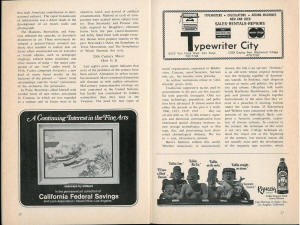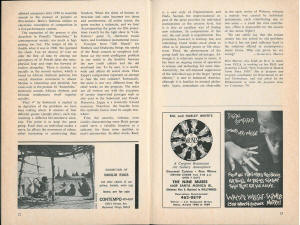UCLA Committee on Fine Arts Productions
May 15
Los Angeles Philharmonic Orchestra
Zubin Mehta, Conducting
with
Frank Zappa and The Mothers of Invention
About the Artists
ZUBIN MEHTA, in his eighth year as music director of the Los Angeles Philharmonic, has guided it to an enviable position among the world's great orchestras.
Extremely aware of the dramatic changes taking place in music, his unusual ability to program is reflected in the greatly increased attendance of young people at series concerts.
His extensive tours have brought the Philharmonic to the attention of the music world. In 1967 Mehta led the Orchestra on its first tour of the Eastern
Born in
MEL POWELL, one of the preeminent figures in contemporary music, has composed more than 35 compositions of piano, choral, orchestral and electronic music. Prior to his appointment as dean of the
THE MOTHERS OF INVENTION is or was a group of musicians, depending which week you read this. Today they playa progressive music - a concoction of blues, rock 'n roll, jazz and pop, satire and weirdness, classical and, more recently, electronic chamber music. Spiced with social commentary and spontaneous remarks from Frank Zappa, their performance on stage rarely fails to be as varied as a submarine sandwich.
Even with such an abundance of talent, style and inventiveness, the Mothers' records receive only occasional airplay on the radio. Their fame has spread, not by promotion and publicity, but by word of mouth. Freak Out, their first album, was bought initially by the odd-one-out, the freak or weirdo in each town and, by the process of a friend playing his copy for a friend , the word passed down the line. Freak Out has finally, after four years, reached the coveted goal: raw weasels. The seven subsequent albums have sold in large quantities by the same process: Absolutely Free, We're Only in it for the Money, Lumpy Gravy (solo album by Frank Zappa), Cruisin' With Ruben & The Jets, Uncle Meat, Hot Rats (solo album by Frank Zappa), Burnt Weenie Sandwich. (The first four albums and Freak Out were recorded by MGM/ Verve; the latter three by Bizarre/Reprise.)
During the time since the Mothers of Invention's inauguration on Mothers' Day 1965, the band had changed constantly, both musically and in size. Their overall appearance is often unpolished, but this does not disguise the complexity of Zappa's music or the expert manner in which it is played.
"200 Motels," excerpts of which comprise the evening's final presentation, is an origin al Zappa-composed orchestral choral- ballet which full blown runs approximately two and a half hours. The lengthy second movement featuring Chunga, the powerful but obliging industrial vacuum cleaner, will not be included. Most of the music was composed in the motels of the
FRANK ZAPPA - lead guitar, drums, conductor and leader - composes and writes all the music and lyrics. He is married with two children and is P resident of Bizarre, Inc., and Straight Records.
JEFF SIMMONS - bass and vocals - was formerly with the group
IAN UNDERWOOD - all keyboard instruments, saxophone, clarinet, flute and guitar - has an M.A. in music and was a child prodigy at the piano. He joined the Mothers in September of 1967.
RAY COLLINS - vocals - is one of the four original members of the group.
DON DEWILD PRESTON - all keyboard instruments and weirdness - joined the group in the summer of J 966 in
BILLIE MUNDI - drums - joined the group in
JAMES MOTORHEAD SHERWOOD - bass saxophone, tambourine and bizarre routines - was originally the group's Road Manager. He has teen appeal and is single.
About the Program
20th CENTURY MUSIC:
HOW IT WAS, HOW IT IS
We await the opening sounds of a concert devoted to 20th Century music, hoping, perhaps, for some diversion from the endless number of crucial problems plaguing the "real" world outside the auditorium. Technologically capable of achieving either Utopia or extinction, more and more of our efforts to reach the former perversely bring us closer to the latter.
Social analysts tell us (even if they didn't, it takes but little common sense to realize it) that art reflects reality. It is useless to hope that music, which is part of this world, will divert us from it. No. The social problems around us are also confronted by the artist in his own particular media and forms. Recently it has been suggested that these art forms not only reflect social problems, but may provide models for their solution as well. Whether or not the multitude of solutions presented in this series has any relationship to social problems or merely provides interesting entertainment is left for you to decide.
20th Century Music:
How It Was
Many of today's problems were already in existence when Schoenberg, Webern, and Stravinsky composed the works included on the May 3, 10 and 31 concerts. By 1906, the year Schoenberg completed his first Chamber Symphony, the world was already aware of the dichotomy between man's prowess in science and technology and his ignorance of, or disregard for, human needs. The by-product of man's increased productivity in the industrial society was human pollution - dehumanization through the mechanization of large numbers of people in machine-filled factories. Freud's new theory of the unconscious and the findings of behavioral psychologists in the laboratories provided further evidence of mechanization with descriptions of man as an unthinking, "conditioned" animal controlled by unconscious primitive urges.
The angst and alienation produced by an urban industrial society is reflected in the German Expressionist movement. The paintings of Kirchner, Kokoschka, Kandinsky, and Munch find their musical equivalent in Schoenberg's Chamber Symphony. The unconscious, filled with powerful and irrational passions, is described by the high intensity, almost hysterical, emotional level sustained throughout most of the work. Lyrical themes swirl by and disappear in a raging torrent of dense and dissonant counterpoint. Thus, in its expressive style, Schoenberg's Chamber Symphony reflects the world around him. A solution to the problems faced by the individual in modern society is suggested at the technical level. In musical terms, Schoenberg says: 1) Reduce the population! (The Chamber Symphony represents a departure from late 19th Century tradition in that it reduces the huge orchestral forces to a mere 15 players.) 2) Allow each member of the society an individual and vital role. (In the Chamber Symphony, instrumentalists have soloistic roles.) In essence, the piece shows that an extremely heterogeneous group (contrapuntal, dissonant) of individuals (soloists) can work together successfully when they have common themes and goals.
In the two works of Webern selected from this period (Five Pieces for Strings, 1909, and Six Pieces for Orchestra, Opus 6) , the idea of Schoenberg's Chamber Symphony is considerably extended. In Webern, an effort is made to give every note of every instrument the right to be beard. This is achieved technically by extreme differentiation in attack quality and the timbral possibilities of each instrument. In effect, Webern seeks out and emphasizes everyone's individual qualities. In order to make this high degree of individual participation possible, each instrument speaks for a shorter time. Each condenses his utterance to its ultimate expressive essence. Not one note is extraneous. It is as though Shakespeare's Romeo and Juliet were condensed into one intense paragraph that contained the full impact of the play.
Webern's revolutionary approach to time, both in the overall microscopic length of his pieces and the unique rhythms within them, reflects and predicts the most salient phenomenon of the 20th Century - the condensation of time. Only with the super-jet and electronic communication does the rest of society catch up to Webern.
In Paris, traditionally more objective and less introspective than Germany, the Fauvists, too, pursued the Irrational by using strong forceful colors in an imaginative, emotional way rather than realistically (red skies, etc.) . An additional and significant source of inspiration was the World Exposition of 1899, which began the process of condensing geographic space by bringing the cultures of Africa, the Orient, and
By the middle of the century (1920- 1950), the world faced bigger and more complex problems. Nationalistic tendencies conflicted with new internationalistic necessities (
The Dadaists, Surrealists, and Futurists reflected the anarchic or disorderly dimension in art. These movements developed a present/ future oriented aesthetic that resulted in radical new art forms often constructed out of everyday or found objects, such as newspaper clippings, cabaret tunes, machines, and other sources of noise - the major component of our "real" audio world. In 1936, Varèse composed Intégrales, a new kind of music based mainly on the harmony of the present - "noisy" tonal relationships, and the "noise" instruments of the orchestra, the percussion.
In Paris, Stravinsky allied himself with another form of new order, articulated by Cocteau, in which art was regarded as a science and its forms were to be 20 objective, lucid, and devoid of artificial ornamentation. Method or craft of composition were exalted above subject matter. Thus Stravinsky and Picasso (initially inspired by Diaghilev) exhumed forms from the past (neo-Classicism) and deftly filled them with simple everyday themes from popular sources or the past. Stravinsky's Octet, the Symphony in Three Movements, and The Symphonies of Winds illustrate this style.
20th Century Music:
How It Is
Last night's news report indicates that none of the problems of the century have been solved. Alienation in urban society has increased. Man's irrational dimensions still threaten us with sudden extinction. Mid-century internationalist strivings are now contained in the United Nations, but hardly less constrained by hidden nationalism than they were in the Twenties. The need for new types of social organization, expressed in Bolshevism, Fascism, neo-Classicism, Surrealism, etc., has become more pressing.
As archaic institutions refuse to yield, disorder grows daily.
Traditional suppressive tactics used by governments in the past are less successful with guerrilla insurgents. Only science, technology, population, and pollution have advanced. It almost seems that either the present or the past is a myth. 1906, 1923, 1939, 1945 . . . they are all till with us. If, in this century, superjets and electronic communication have eliminated spatial distance between us, new storage technologies, such as film tape, disc, and print-setting have eliminated chronological distance. We live in a vast, all-inclusive present.
Berio's Sinfonia reflects this world. Whether consciously or unconsciously chosen, the title is an apt one. "Sinfonia" is an old term whose original meaning was the bringing together of harmonious sounds. In Sinfonia, such disparate sources as music and politics, the primitive and urbane (Brazilian folk myths beside Karlheinz Stockhausen), and the past and present are brought together harmoniously in the sense that they coexist in a peaceful, if exciting, fashion under the same baton. If Schoenberg and Webern were concerned with the expression of the individual, Berio composes a fantastic counterpoint, expressive of diverse cultures. In contrast to the content, the technique of this work is not very new. Collage technique entered the visual arts at the beginning of the century, but musical means did not actually exist until the development of the magnetic tape recorder, which allowed composers after 1950 to assemble sounds in the manner of painters or film-makers. Berio's Sinfonia utilizes an electronic conception of composition in a live-performance context.
The expansion of the present is also described in Powell's "Immobiles." In contemporary society, too much is happening too fast. The tempo of life is double what it was in 1900. We invented the clock. Can we destroy it? Can we alter the flow of time by altering our perception of it? Powell takes the metaphysical leap and stops the forward direction altogether. There is motion, especially in the second section, which is based on African rhythmic patterns, but overall direction movement is absent. Motion is interesting and plentiful, but exists only in the present. In "Immobiles," electronic sounds, African rhythms, and Oriental timelessness dwell together amiably.
"Play! 4" by Subotnick is explicit in its depiction of the problems we have been talking about. It consist of four different games (people play), each representing a different life-emulative situation. The point is to keep the game going. Each time an individual makes a move, he affects the movement of others, either increasing or constricting their 22 freedom. When the skein of human interaction and rules becomes too dense and cumbersome, all action ceases, the game reaches a stalemate, and we lose! Accompanying the game are film projections (watch for the light show in "Celebration," game 3), electronic music tapes, and traditional instrumental music.
Excerpts from "200 Motels" for Mothers and Orchestra brings the smoke of the Rock concert to symphony hall. Some say the most conflagrant problem in our midst is the hostility between the new youth culture and the old moribund one. To be sure, it is worldwide and affects all social strata. Does Zappa's composition represent an attempt to fuse the two cultures? Technically, the piece is not very different from the other works on the program. The notes are all written out with the exception of certain improvised passages such as also exist in the Subotnick and Powell. Moreover, Zappa is a classically trained musician. Therefore, the benefits from this symbolic fusion must be sought elsewhere.
First, the anarchy, violence, even crudity characterizing some Rock groups could serve a valuable function as a catharsis for these same qualities in man's unconscious. In other words, Rock is a new style of Expressionism and Dada. Second, the improvisational aspect of the piece provides for individual participation at the creative level, but it is also an excellent way of finding new solutions. In compositions of this sort, the end result is unpredictable. The procedure, however, is exciting, fun, and interesting. Good results occur about as often as in planned pieces or life situations. Third, the phenomenon of the group itself has specified advantages. Although it is relatively recent in music, it has been an ongoing means of operation in science and technology for some time. Anonymity, the self-imposed suppression of the individual ego to the larger "group identity," is new to Industrial America, although it is familiar in oriental philosophy. Again, antecedents are observable in the early works of Webern, wherein a melody was created by individual instruments, each contributing one or two notes - a small but vital contribution. (Who is responsible for the success of the moon flight?)
We can safely say that the reason society has not solved its old problems is that it has not paid sufficient heed to the solutions offered in contemporary music forms. Who can prove we are wrong?
- Genevieve Marcus
Miss Marcus, who holds an M.A. in music from UCLA, is working on her Ph.D. and preparing a book, "New Concepts in Musical Form Since 1950." She is designer and program coordinator for Experiments in Art and Technology, and was asked by the Philharmonic to write the program notes for Contempo '70.
Source: slime.oofytv.set








